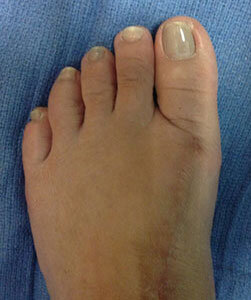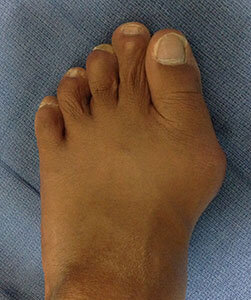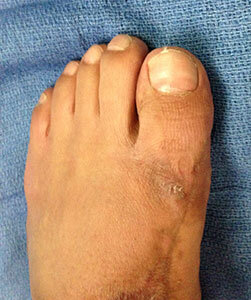Get Relief From Your Bunion Pain - Foot Doctors & Surgeons in Torrance, San Pedro & Los Angeles
BUNIONS
Our doctors perform the most advanced and precise surgical techniques available. Most patients are able to return to shoes 3 weeks after surgery unless it is a severe deformity. Our recurrence rate is less than 5% and more than 80% of our patients only require Tylenol or advil post-operatively for mild pain control. We typically use screw fixation which allows for early range of motion exercises to help you return to your full activities quickly.
What causes a bunion? Bunions are primarily a hereditary condition. They can affect anybody. As we walk more and more the symptoms become worse and worse. As the bunion deformity increases in severity it can cause many other associated foot problems, such as hammertoes, arch pain, and painful calluses on the bottom of the foot. A bunion occurs due to mechanical instability in the foot. This results in a malalignment of the bones with the big toe drifting toward the second toe. As this progresses, we begin to notice a large bump behind and on the inside of the big toe.
Do lasers get rid of bunions? The much publicized laser technique is severely limited because lasers can only cut soft tissue and not bone. Therefore, the laser technique cannot realign the bone, which is the most critical part of a successful bunionectomy.
What’s unique about our advanced techniques to bunion correction? We feel to appropriately correct the bunion, all of the adaptive changes must be addressed to ensure appropriate function and reduce recurrence. Our technique utilizes surgical engineering to realign the bone for proper function and then utilizes a surgical screw for the most stable fixation, which enables us to reduce many of the potential hazards of bunion surgery.
Traditional Bunionectomy
Often is done under general anesthesia.
Many times requires a full leg cast or steel pins which protrude from the toe for severe bunions.
Often minimal walking for as much as four months after surgery.
Not wearing shoes for prolonged periods of time and unable to exercise for 4-6 months.
Precision Foot and Ankle Bunionectomy Procedure
Performed under local anesthesia with IV sedation
A small surgical screw in the bone, that in most cases never has to be removed.
Most Patients walk immediately after surgery without crutches.
The patient usually returns to soft soled (tennis) shoes within 3 weeks and exercise in 2-3 months.
Do bunions ever come back? No surgeon can guarantee perfect results. Unfortunately, if the wrong procedure is performed, the recurrence rate can be very high. Many of the new minimal incision and laser techniques have a high recurrence and complication rate because they generally cannot accurately realign the bones.
When should I have bunions corrected? If you have several of the following problems, your feet should be evaluated.
Calluses on the inside of the big toe.
Pain around the big toe with certain shoes.
Painful calluses on the bottom of your feet.
Big toe pushing on the second toe.
Difficult wearing shoes.
Our Outcomes are significantly better than older techniques of repair.
Most of our patients experience minimum discomfort.
The advanced bunionectomy procedure is done on an outpatient basis. Traditionally, bunionectomies were done in hospital and the patient’s experienced severe post-operative pain and were unable to walk. More Than 80 % of our patient’s experience severe post-operative surgery which is well controlled with extra strength Tylenol or Advil. Those who do have discomfort usually require pain medication only for the first few days after surgery. Additionally, this surgical technique stabilizes the bone allowing our patients to walk the same day as their surgery.
The majority of our patients wear tennis shoes 3 weeks after the surgery.
With traditional bunion surgery, return to shoes has often been delayed by pain, swelling, and the inability to walk because of pins or instability of the bone. The utilization of the surgical screw significantly reduces pain and swelling, Security of the bone realignment usually allows for immediate weight bearing and walking without the need for full leg casting. Patients are generally ready to begin wearing shoes in 2-3 weeks.
Traditionally, pins and casts have used to hold the alignment if the bones. The pins stuck out of the foot and prolonged the return to shoes by more than a month. The surgical screw is beneath the skin, and is much more stable than pins. To ensure the best possible results, patients begin home exercises with a physical therapist to help with the healing process and increase the flexibility of the corrected joint. Now there is no need to be afraid of bunion surgery anymore. Please schedule an appointment with Precision Foot and Ankle Centers to learn more about all of your treatment options.





